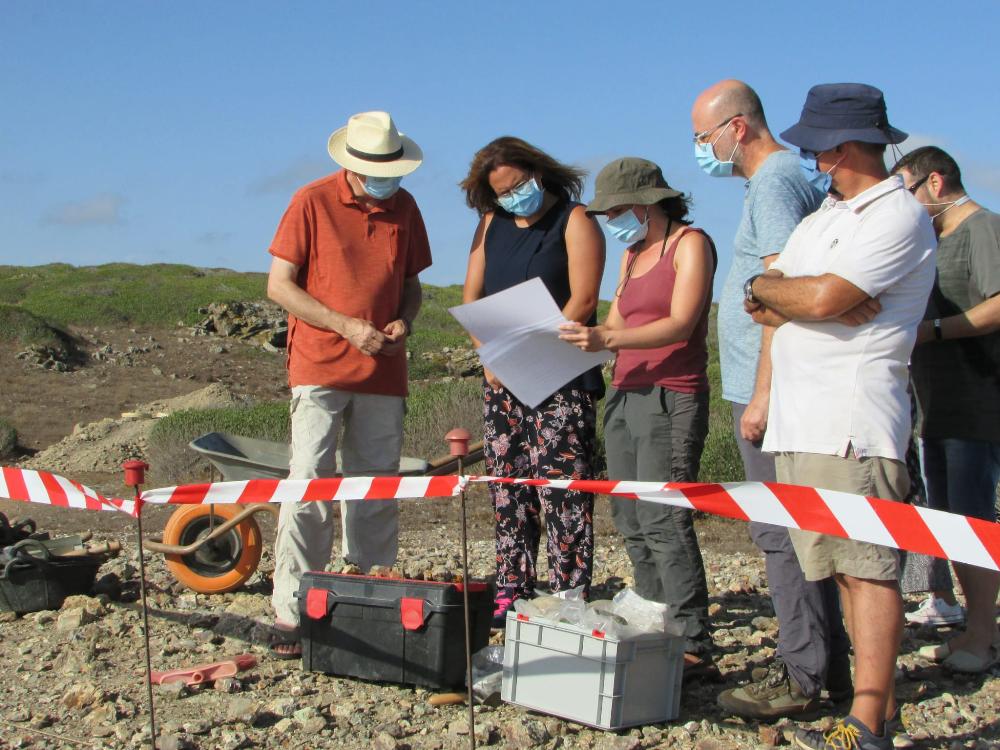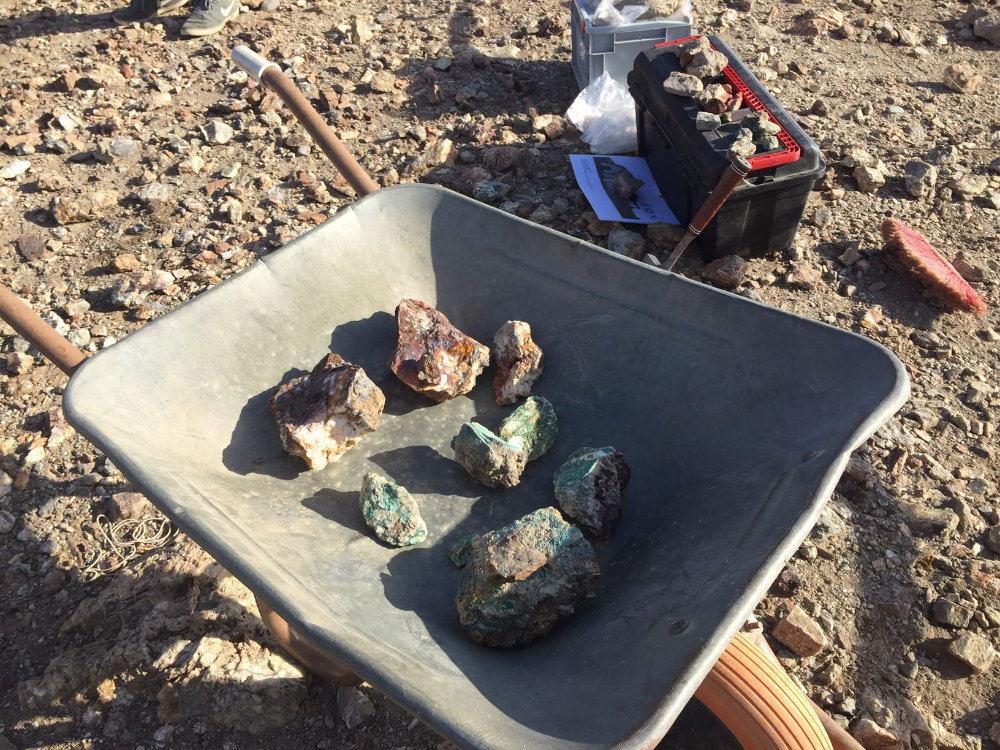 Sa Mitja Lluna is a very special site for its uniqueness, its good state of conservation and the location. It is the only copper mine with evidence of prehistoric exploitation that has been documented in the Balearic Islands. In addition, it is placed in a privileged location, such as Illa d’en Colom, within the Natural Park of s'Albufera des Grau (Maó).
Sa Mitja Lluna is a very special site for its uniqueness, its good state of conservation and the location. It is the only copper mine with evidence of prehistoric exploitation that has been documented in the Balearic Islands. In addition, it is placed in a privileged location, such as Illa d’en Colom, within the Natural Park of s'Albufera des Grau (Maó).
The excavations at sa Mitja Lluna represent the culmination of the job done in the years prior to its discovery. The ArqueoUIB team (University of the Balearic Islands) had been looking for evidence of prehistoric exploitation of copper minerals both in Mallorca and Menorca since 2007. In 2010, the prehistoric site was finally located.
Later, in 2012 and 2014, a team with members of the University of the Balearic Islands (UIB) and the University of Seville (US) carried out two small archaeological explorations that confirmed that this mine dated back to the Bronze Age, and recovered a significant amount of archaeological material. The study of these materials, as well as the physico-chemical analysis of the minerals that can be found there, have made it possible to collect important information about the resourcing strategies of prehistoric communities, not only in Menorca but also in the other islands of the archipelago.
In 2019 began a new stage in the investigations of this site with a long-term project that will allow to deepen awareness about the technological capabilities for mining during those times, as well as acquiring more information about the people who carried out these activities and used this resource .
Furthermore, these investigations take on special relevance within the framework of the Talayotic Menorca candidacy. The candidacy has undergone some modifications at the request of ICOMOS, to add more value to the landscape associated with the archaeological sites. In this case, we have the Torreta de Tramuntana close by, which was already in the previous candidacy file. But now, with the new approach, more than 500 hectares around the Torreta de Tramuntana, Illa d'en Colom and the channel of water that separates Illa d'en Colom from land have been added to the candidacy.
Working in the mine
Sa Mitja Lluna is a mining site located under the open sky, on the edge of a cliff shaped like a semicircle, an orography that gives its name ( Mitja Lluna=half moon). Normally, the area where minerals are found is exploited constantly over the years, each time with new techniques that erase previous works. In this aspect, sa Mitja Lluna is an exceptional site since there are no subsequent exploitations that have damaged the prehistoric evidence. We could say that the mine remained intact, just as the last prehistoric miners left it.
.jpeg) The excavations on one of the debris has revealed the existence of a trench carved out on the rock, probably following a copper vein that should have run more or less parallel to the cliff in a NS direction. Before the archaeological explorations, this trench was invisible and its presence could not be detected since it was completely filled with rubble. This debris grows beyond the natural level of the rock, forming a small elevation and making this works invisible.
The excavations on one of the debris has revealed the existence of a trench carved out on the rock, probably following a copper vein that should have run more or less parallel to the cliff in a NS direction. Before the archaeological explorations, this trench was invisible and its presence could not be detected since it was completely filled with rubble. This debris grows beyond the natural level of the rock, forming a small elevation and making this works invisible.
Likewise, it should be noted that the intervened area seems to be only a small part of the trench. The trench’s depth in the area intervened on the 2019 campaign cannot yet be confirmed, since all the stratigraphy has not been exhausted. It seems that the mining works enter irregularly in the westernmost part of the subsoil, while in the eastern part of the trench (the part closest to the cliff), the level of the bedrock is higher. The existence of galleries or wells is not ruled out.
Among the mining debris we find quartz rocks with primary (chalcopyrite) and secondary copper minerals (malachite, azurite, etc.) Regarding the archaeological materials, the explorations have made it possible to document ceramic remains next to the documented work fronts, although this ceramic always appears very fragmented, making very difficult to identify forms. On the other hand, pastes and degreasers allow us to attribute a relative chronology that places us in the Bronze Age, this being consistent with the results of radiocarbon dating.
For now, the presence of ceramics has not been linked to processes related to mineral treatment, so we must probably relate it to the consumption of food and beverages at the mine, since fauna remains have also been found.
On the other hand, lithic mining tools are numerous, both on the surface and among the material of the dumps. Various types of tools have been found, defining probable uses from their characteristics and approximate weight calculation in their initial state. Most of these tools are made from pebbles selected for their weight, slightly oval shape, and grain size. We think that these pebbles were brought there from one of Illa d'en Colom’s coves where this type of stones abound: the one known as Punta des Macs, about 750 m from Sa Mitja Luna.
There are some types of tools that have, to a greater or lesser extent, notches and specific modifications and that are poorly defined by their handle.
There are other larger tools, stones that can weigh about 16 kg. These tools do not show modifications to put a handle on them, but they do show signs of use or breaks in the proximal and distal areas, caused by their use as hammers. These great tools were most likely used with two hands, using their weight to hit and break the rock. Some of them also have pecking marks in their ventral area due to having been used as a mortar or anvil.
Small hammers that could have been the complement of these “anvils" have also been recovered. These are small pebbles that have marks on one end from having been used for chipping. The size of these tools is suitable for direct use with one hand and without a handle. Based on this type of tools, the hypothesis about a phase of crushing and mineral selection at the foot of the mine was suggested.
For now, no stable settlements or permanent constructions of this chronology have been found in Illa d'en Colom, but it is not ruled out that the miners made seasonal camps. This is very difficult to identify, since these camps would basically consist of rest areas with simple and ephemeral infrastructures, often archaeologically invisible on the surface.
What did the exploitation of this Menorcan mine mean for the prehistoric communities of the Balearic Islands?
 The study of this mine, alongside with several analyticals of other minerals from the islands, suggests that the minerals from Menorca could have had an important role in the supply of raw materials for the other islands. It is important to bear in mind that, from the studies carried out so far, Sa Mitja Lluna mine was not a large-scale operation (comparing with the Roman mines or those of the industrial era, for example), so it is likely that there were other mines operating in Menorca during the Bronze Age.
The study of this mine, alongside with several analyticals of other minerals from the islands, suggests that the minerals from Menorca could have had an important role in the supply of raw materials for the other islands. It is important to bear in mind that, from the studies carried out so far, Sa Mitja Lluna mine was not a large-scale operation (comparing with the Roman mines or those of the industrial era, for example), so it is likely that there were other mines operating in Menorca during the Bronze Age.
Thanks to the investigations in Sa Mitja Lluna, other studies carried out on metal archaeological pieces show the possible arrival of copper from Menorca in Mallorca, and even in the Pitiusas. Within the same island of Menorca, metals possibly made with native copper have been detected, such as in the Cova des Pas necropolis or in the Cova des Càrritx.
On the other hand, although we are talking about islands, it must be said that Menorca and the rest of the archipelago are not isolated territories. It is clear that all the islands maintained an intense connection, but they were also connected with other places in the Mediterranean. The analytics on metals from the Bronze Age also show us the arrival of raw materials from different places such as the south of the peninsula, Catalonia, the south of France and Sardinia.